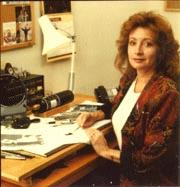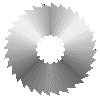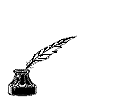P. D. Crowe's Wax Modeling Page

 P. D. Crowe,
Wax Sculptress
P. D. Crowe,
Wax Sculptress
Wax sculpting might bring to mind the image of a candle carver,
but though I love carving and candles, the sculptures I make are
the prototypes for jewelry and miniature collectibles. From the
original image of the item desired, it is my job to create a
three-dimensional object (the model) in wax. Each item can take
many hours or even days to complete. Every detail must be clean
and as perfect as possible to express a faithful image of the
original design.

 Casting
Casting
The wax model is then sent to a caster whose job it is to
transform the model into a more durable medium (metal) through
the "lost wax" casting process. In that process, the
model is embedded into a liquid plaster-like substance which in
its curing, hardens around the model which has a wax "sproue",
or "gate" attached to permit access of the flow of the
metal. This plaster is called the investment, and it is contained
in a metal cylinder, or flask. After the investment has hardened,
the flask is baked until the wax model melts away completely,
leaving a negative space inside the investment. This is where the
term "lost wax" comes from. A casting failure at this
point will truly mean a lost wax, and the original will have to
be done all over again! Finally, molten metal is introduced to
the negative cavity in the investment through the negative cavity/channel
created when the wax sproue melted away in the baking. The result
is a positive metal duplication of the original wax model.

 Finishing and Production
Finishing and Production
Finally, when the original metal model is cast, it goes to the
finishers who will enhance the surface by cleaning up any casting
imperfections and smooth and polish it to the final shine. The
individual pieces must go through a polishing by various grits of
polishing compounds until they shine perfectly with a mirror
finish.Each step of the process is a specialty art in itself! For
production, the original metal model which was cast from the
original wax model must be molded before going to the final
finish; usually by a latex rubber or silicon-based medium. Hot
molten wax will then be pressure-injected into this mold, making
another wax model (copy) and then the whole process repeats
itself again. (...and you wonder why jewelry costs so much?:)

 Tools
Tools
The first wax I ever carved was created over a candle flame in my
kitchen using one bulky dentist tool, a reshaped paperclip and an
exacto knife. I really didn't know what I was doing, but the next
morning I had a model of a Pisces pendant featuring two fish
swimming around each others' bellies. Fortunately, the folks at
My Jewel Shop bought it and the customer liked it enough to cast
it into gold. It must have weighed about two ounces! Thankfully,
gold was only about fifty-five dollars an ounce back then. I
immediately got some decent tools from a friend who ran a dental
lab, and currently use one of those very same tools, a double-ended
flat spoon, every day. The best tools for my purposes are the
scrapers and probes which I file down to meet my needs. Sometimes
I will recycle a broken scraper into a flat-ended channel cutter,
which is great for flattening horizontal interior areas. For heat,
I use a small propane pencil flame torch. I used to have a huge
25 pound tank but didn't like the torch much.. it burned too slow.
I'm sure there are probably more modern versions of that set-up,
but I'm kind of comfortable with what I'm used to! For smoothing
the surface, I like 400-600 grit silicon carbide paper. Sometimes
I use up to a 120 grit for preliminary shaping of large objects.
The roughness can always be taken down smoother as the work
progresses. I work using a #7 or #10 magnifier loupe when I am
creating the models. Many modelmakers "cold carve"
their work, but I prefer to work with small additions of hot wax,
building up my sculptures as if they were being painted in 3-D.
For the final details, I use a combination of hot and cold
carving techniques, solvents and fine sable artists brushes to
get the surface texture as clean and dustfree as possible. Even
dust particles will cast if they are left on the surface of the
model. My motto is that a good model should be nearly wearable
right out of the casting flask... though at that point the
casting has a sort of powdery matte finish that resembles
sandblasting.

 "Herstory"
"Herstory"
I got my start in Philadelphia in 1972 and worked there in the
jewelry trade first as the modelmaker for My Jewel Shop, then as
a freelance artist from my own studio for local manufacturers and
custom jewelry stores. Along the way, I met many talented and
wonderful folks who helped me learn more about the practical,
technical, and business aspects of the jewelry trade. Over the
course of the next 23 years, I was fortunate to include clients
from all over the United States by communicating through the mail.
In 1995, I was privileged to meet Chip deMatteo and left
Philadelphia to work with him and "the family" at Hand
& Hammer Silversmiths in Virginia. Since I love doing
sculpture items rather than "straight line jewelry",
this was a wonderful opportunity for me to really express myself
as a sculptor. Whether carving wax or wood (I do songbirds in
wood.. but that's another topic) it's a great feeling to know
that my work will live on after I am gone and that the items I
create often become heirlooms with sentimental value for
generations to come. Knowing my work has helped someone express
an emotion or image as a gift or keepsake is probably the
greatest reward of my profession!



Interesting
Links:

Copyright 2004-2021 P.D. Crowe
All Rights Reserved
 P. D. Crowe,
Wax Sculptress
P. D. Crowe,
Wax Sculptress
 Casting
Casting Finishing and Production
Finishing and Production Tools
Tools "Herstory"
"Herstory"
